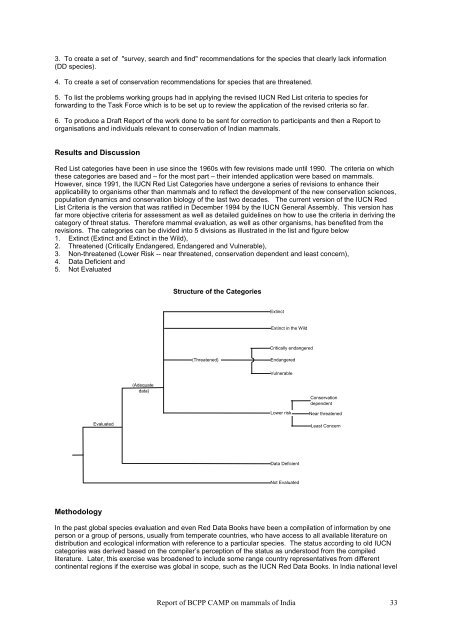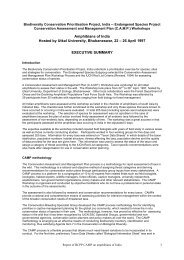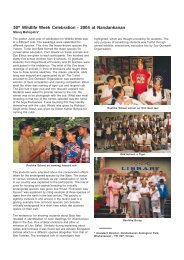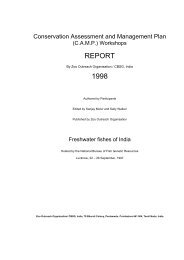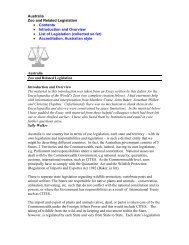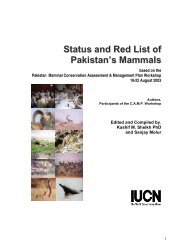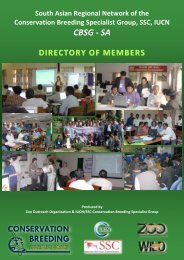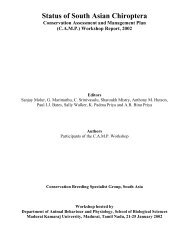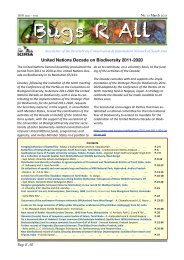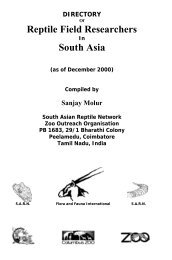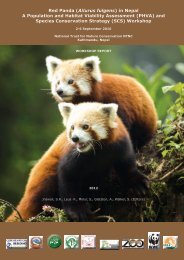In preparing <strong>for</strong> the workshop, a major task was to locate the most complete and current checklist <strong>of</strong> mammals,which was not so straight<strong>for</strong>ward as one might expect <strong>for</strong> the most well studied <strong>India</strong>n animal group. Over thecenturies there have been several books and lists <strong>of</strong> <strong>India</strong>n mammals. Probably the first systematic attempt tolist the mammalian fauna <strong>of</strong> <strong>India</strong> is a little-known one. In 1801, Arthur Wellesley, a brilliant albeit tactless,Governor General <strong>of</strong> Bengal, wanted to set up a Natural History Institute in a special college which would caterto English babus who were to serve in <strong>India</strong>. Wellesley desired to give them a firm grounding in <strong>India</strong>n languageand culture be<strong>for</strong>e sending them to the districts, but his Board <strong>of</strong> Governors did not agree. They did, however,grant permission and a modest budget <strong>for</strong> the <strong>India</strong>n Natural History Project, probably the most amphibious<strong>of</strong>ficial project <strong>of</strong> its type to that date. Wellesley engaged Sir Frances Buchanan-Hamilton, a surgeon naturalist,to serve as Director <strong>of</strong> the Project. The project was ill fated and did not survive long, but during the three orfours years that it lasted, some nearly 200 species <strong>of</strong> mammals, birds and reptiles were listed, described anddrawn. This work was never published and is currently being edited and annotated by one <strong>of</strong> the editors <strong>of</strong> thisReport (Walker, work in progress). Hamilton-Buchanan has the credit <strong>of</strong> describing innumerable plants andfishes in <strong>India</strong>.According to Nameer (in press), the Golden Age <strong>of</strong> <strong>India</strong>n Mammology was during second quarter <strong>of</strong> the 19thcentury, led by Brian Houghton Hodgson (Wroughton, 1918). Be<strong>for</strong>e Hodgson, with the exception <strong>of</strong> Buchanan,collecting and study was sporadic. T.C. Jerdon’s The <strong>Mammals</strong> <strong>of</strong> <strong>India</strong>, published in 1867, may have been thefirst published listing with 242 species. Robert A. Sterndale’s Natural History <strong>of</strong> the Mammalia <strong>of</strong> <strong>India</strong> &Ceylon, 1884, described 482 species <strong>of</strong> mammals from <strong>India</strong> and much <strong>of</strong> what we call south Asia today, e.g.,Nepal, Pakistan and Sri Lanka. In 1888 and 1891 W.T. Blan<strong>for</strong>d published the first part <strong>of</strong> The Fauna <strong>of</strong> British<strong>India</strong>, Mammalia, in which 400 and odd species were listed and described. This work is said to be the firstauthoritative account on <strong>India</strong>n mammals. Two decades later BNHS began a Mammal Survey <strong>of</strong> <strong>India</strong>, whichcontinued till 1923 with results being published in their journal between 1912 and 1930. Following the BNHSMammal Survey, a second edition <strong>of</strong> the Mammalia <strong>of</strong> the Fauna <strong>of</strong> British <strong>India</strong> series was published in 1939(primates), in 1941(carnivora) by R.I. Pocock, and 1961 (rodents) by J.R. Ellerman. A Checklist <strong>of</strong> Palearctic &<strong>India</strong>n <strong>Mammals</strong> was published by Ellerman and Morrison-Scott in 1951. The most popular reference onmammals in recent years is S.H. Prater’s Book <strong>of</strong> <strong>India</strong>n Animals, first published in 1948 then updated andreprinted several times since. Wildlife Institute <strong>of</strong> <strong>India</strong> developed a database <strong>of</strong> mammals in protected areaswith common names as well as scientific names.With all <strong>of</strong> these works in existence, the organisers <strong>of</strong> this workshop were still hard pressed to find a genuinechecklist <strong>of</strong> <strong>India</strong>n mammals with any degree <strong>of</strong> real currency. Finally it was learned that P.O. Nameer <strong>of</strong> KeralaAgricultural University, Thrissur with the help <strong>of</strong> Dr. Lawrence Heaney <strong>of</strong> the Field Museum, Chicago hadcompiled a comprehensive checklist based on the latest nomenclature as published by Corbett and Hill. Thischecklist was indeed the most comprehensive and current and finally taken as the basis <strong>of</strong> the <strong>CAMP</strong> Workshopwith the consensus <strong>of</strong> participants.Despite this, there is still confusion with regard to identification and taxonomy, especially <strong>of</strong> the smallermammals as indicated in the BCPP <strong>CAMP</strong> workshop. Though mammals are a relatively wellstudied group,there are anomalies in validity <strong>of</strong> subspecies and <strong>of</strong> nomenclature even in the higher <strong>for</strong>ms. This was revealedby varied opinions <strong>of</strong> researchers working on the same animal in different parts <strong>of</strong> its distribution. An example<strong>of</strong> this confusion is the <strong>India</strong>n dhole, which was assessed as a single species by the group, some <strong>of</strong> whom hadsurveyed the species, but later divided by the authority on dhole into 4 subspecies. Other examples either <strong>of</strong>name change or confusion in identification include the Himalayan ibex, musk deer, yak, wild buffalo, and otherlarge mammals, as well as the numerous and smaller rodents and bats. There is a clear lack <strong>of</strong> communicationand ccordination among <strong>India</strong>n mammal specialists. Some <strong>of</strong> the common misunderstandings in taxonomy,identification, field techniques, etc. could be resolved through networking which would promote morecommunication and cooperation and there<strong>for</strong>e coordination <strong>of</strong> in<strong>for</strong>mation.The <strong>CAMP</strong> workshop was conducted with a view to bring together as many <strong>of</strong> the country’s current as well asretired mammal field biologists, so that the full depth <strong>of</strong> knowledge regarding population trends and status <strong>of</strong><strong>India</strong> mammals could be fully utilised. This exercise may be the first time that a systematic ef<strong>for</strong>t has made toassess the status <strong>of</strong> a country’s mammalian fauna using IUCN threat criteria and a large group <strong>of</strong> biologists.The BCPP <strong>CAMP</strong> workshops on amphibians and reptiles be<strong>for</strong>e this exercise provided a model example inconducting a countrywide assessment <strong>for</strong> any single group <strong>of</strong> organisms.Objectives <strong>of</strong> the BCPP Mammal <strong>CAMP</strong>1. To create a complete list <strong>of</strong> those species which should be considered the mammalian fauna <strong>of</strong> <strong>India</strong> with theaim <strong>of</strong> an inventory <strong>of</strong> <strong>India</strong>n mammalian biodiversity.2. To assess each species (and where appropriate each subspecies), according to the revised IUCN Red Listcriteria using the <strong>CAMP</strong> workshop process with the aim <strong>of</strong> prioritising species <strong>for</strong> conservation (In the case <strong>of</strong>species not represented by an acknowledged expert, to name an expert and refer the appropriate speciesquestionaire to them <strong>for</strong> up-to-date in<strong>for</strong>mation).32Report <strong>of</strong> BCPP <strong>CAMP</strong> on mammals <strong>of</strong> <strong>India</strong>
3. To create a set <strong>of</strong> "survey, search and find" recommendations <strong>for</strong> the species that clearly lack in<strong>for</strong>mation(DD species).4. To create a set <strong>of</strong> conservation recommendations <strong>for</strong> species that are threatened.5. To list the problems working groups had in applying the revised IUCN Red List criteria to species <strong>for</strong><strong>for</strong>warding to the Task Force which is to be set up to review the application <strong>of</strong> the revised criteria so far.6. To produce a Draft Report <strong>of</strong> the work done to be sent <strong>for</strong> correction to participants and then a Report toorganisations and individuals relevant to conservation <strong>of</strong> <strong>India</strong>n mammals.Results and DiscussionRed List categories have been in use since the 1960s with few revisions made until 1990. The criteria on whichthese categories are based and – <strong>for</strong> the most part – their intended application were based on mammals.However, since 1991, the IUCN Red List Categories have undergone a series <strong>of</strong> revisions to enhance theirapplicability to organisms other than mammals and to reflect the development <strong>of</strong> the new conservation sciences,population dynamics and conservation biology <strong>of</strong> the last two decades. The current version <strong>of</strong> the IUCN RedList Criteria is the version that was ratified in December 1994 by the IUCN General Assembly. This version hasfar more objective criteria <strong>for</strong> assessment as well as detailed guidelines on how to use the criteria in deriving thecategory <strong>of</strong> threat status. There<strong>for</strong>e mammal evaluation, as well as other organisms, has benefited from therevisions. The categories can be divided into 5 divisions as illustrated in the list and figure below1. Extinct (Extinct and Extinct in the Wild),2. Threatened (Critically Endangered, Endangered and Vulnerable),3. Non-threatened (Lower Risk -- near threatened, conservation dependent and least concern),4. Data Deficient and5. Not EvaluatedStructure <strong>of</strong> the CategoriesExtinctExtinct in the WildCritically endangered(Threatened)EndangeredVulnerable(Adequatedata)Lower riskConservationdependentNear threatenedEvaluatedLeast ConcernData DeficientNot EvaluatedMethodologyIn the past global species evaluation and even Red Data Books have been a compilation <strong>of</strong> in<strong>for</strong>mation by oneperson or a group <strong>of</strong> persons, usually from temperate countries, who have access to all available literature ondistribution and ecological in<strong>for</strong>mation with reference to a particular species. The status according to old IUCNcategories was derived based on the compiler’s perception <strong>of</strong> the status as understood from the compiledliterature. Later, this exercise was broadened to include some range country representatives from differentcontinental regions if the exercise was global in scope, such as the IUCN Red Data Books. In <strong>India</strong> national levelReport <strong>of</strong> BCPP <strong>CAMP</strong> on mammals <strong>of</strong> <strong>India</strong> 33
- Page 1 and 2: Biodiversity Conservation Prioritis
- Page 3 and 4: ContentsMammals of IndiaAuthors of
- Page 5 and 6: Ashra, Dr. N.V.K.Coimbatore Zoologi
- Page 7 and 8: Biodiversity Conservation Prioritis
- Page 9 and 10: Mammals of IndiaExecutive Summary
- Page 12 and 13: Vulnerable17 (31.5%)Status of India
- Page 14 and 15: Species Family IUCN CriteriaAlticol
- Page 16 and 17: Species Family IUCN CriteriaMacaca
- Page 18 and 19: Species Family IUCN CriteriaRattus
- Page 20 and 21: IUCN Red List Categories and Criter
- Page 22 and 23: Mammals of IndiaSummary Data Table
- Page 24 and 25: Species Range Area No. ofloc./F%dec
- Page 26 and 27: Species Range Area No. ofloc./F%dec
- Page 28 and 29: Species Range Area No. ofloc./F%dec
- Page 30 and 31: Species Range Area No. ofloc./F%dec
- Page 32 and 33: Species Range Area No. ofloc./F%dec
- Page 34 and 35: Mammals of IndiaReport
- Page 36 and 37: IUCN Criteria for Endangerment used
- Page 40 and 41: exercises such as the Indian Red Da
- Page 42 and 43: SpeciesPrionailurus rubiginosus rub
- Page 44 and 45: SpeciesSuncus dayi *Suncus etruscus
- Page 46 and 47: Species IUCN Distribution in India
- Page 48 and 49: Species IUCN Distribution in India
- Page 50 and 51: Species IUCN Distribution in India
- Page 52 and 53: Species IUCN Distribution in India
- Page 54 and 55: ThreatsLoss of habitat and human in
- Page 56 and 57: Species Threats IUCNBiswamoyopterus
- Page 58 and 59: Species Threats IUCNCervus duvaucel
- Page 60 and 61: Species Threats IUCNMelogale person
- Page 62 and 63: Species Threats IUCNRattus sikkimen
- Page 64 and 65: Trade in non-threatened mammalsLoca
- Page 66 and 67: Research and management recommendat
- Page 68 and 69: scientific breeding technology with
- Page 70 and 71: Table 6. Level of difficulty in bre
- Page 72 and 73: Common name Scientific name IUCN No
- Page 74 and 75: IUCN Red List Criteria Working Grou
- Page 76 and 77: The workshop was a good exercise in
- Page 78 and 79: DATA DEFICIENT (DD)A taxon is Data
- Page 80 and 81: 1. Level one recommendationA captiv
- Page 82 and 83: TAXON DATA SHEETS1. Acinonyx jubatu
- Page 84 and 85: morphological genetic studies; Surv
- Page 86 and 87: Name of facilities: Refer Appendix.
- Page 88 and 89:
Occupied (Sq. Km): < 500. -Number o
- Page 90 and 91:
and temperate. Global Distribution:
- Page 92 and 93:
Area Occupied (Sq. Km): > 2,000. -N
- Page 94 and 95:
54. Chiropodomys gliroides (Blyth,
- Page 96 and 97:
Regional Distribution: Andaman & Ni
- Page 98 and 99:
Pradesh, Bihar, West Bengal, Assam.
- Page 100 and 101:
83. Elephas maximus Linnaeus, 1758
- Page 102 and 103:
population monitoring; General fiel
- Page 104 and 105:
to Bombay. -Elevation: Sea level-15
- Page 106 and 107:
(Namdapha). -Elevation: Up to 1000
- Page 108 and 109:
Appendix III. -IWPA (1972;91): Sche
- Page 110 and 111:
Sikkim. Threats: Not known. Trade:
- Page 112 and 113:
known. Other Comments: —. Status:
- Page 114 and 115:
difficulty: Not known. Exisiting Ca
- Page 116 and 117:
Not known. -No of Mature Individual
- Page 118 and 119:
Population: Not known. Regional Pop
- Page 120 and 121:
-Area Occupied (Sq. Km): > 2,000. -
- Page 122 and 123:
known. Data Quality: General field
- Page 124 and 125:
193. Murina grisea Peters, 1872 —
- Page 126 and 127:
Individuals: Not known. Global Popu
- Page 128 and 129:
Captive breeding: Pending. -Level o
- Page 130 and 131:
Asia. Current Regional Distribution
- Page 132 and 133:
Population: None in India . -Name o
- Page 134 and 135:
243. Ochotona nubrica Thomas, 1922
- Page 136 and 137:
fragmented location). -CITES: Appen
- Page 138 and 139:
No of Mature Individuals: Not known
- Page 140 and 141:
Sources (Refer Appendix): 20, 38, 2
- Page 142 and 143:
Collections). Recent Field Studies:
- Page 144 and 145:
occupancy and/or quality of habitat
- Page 146 and 147:
Population: None in India. -Name of
- Page 148 and 149:
ecord of breeding small mammals. -N
- Page 150 and 151:
None in India. -Name of facilities:
- Page 152 and 153:
in Tirunelveli; Bates et al., .1992
- Page 154 and 155:
iver side. Global Distribution: Nep
- Page 156 and 157:
Chakraborty & Pradhan in Western Gh
- Page 158 and 159:
in India. -Name of facilities: —.
- Page 160 and 161:
field study (A. Choudhury, 1986-89
- Page 162 and 163:
371. Vandeleuria oleracea (Bennett,
- Page 164 and 165:
SOURCESTaxon Data Sheets1. Abey (19
- Page 166 and 167:
77. Choudhury, A. U. (1997). The st
- Page 168 and 169:
164. Kumar, A. (1987) Ph.D thesis.
- Page 170 and 171:
240. Prakash, Ishwar (1995). J. Mam
- Page 172 and 173:
314. Suthakar Isaac, S. and Marimut
- Page 174 and 175:
Prani Sanghrahalay; 22. Aurangabad
- Page 176 and 177:
Corner; 20. V.O.C. Park Mini Zoo; 2
- Page 178 and 179:
Nandankanan Biological Park; 8. Mah
- Page 180 and 181:
Toronto zoo; 14. Yulee zoo; 15. Ban


